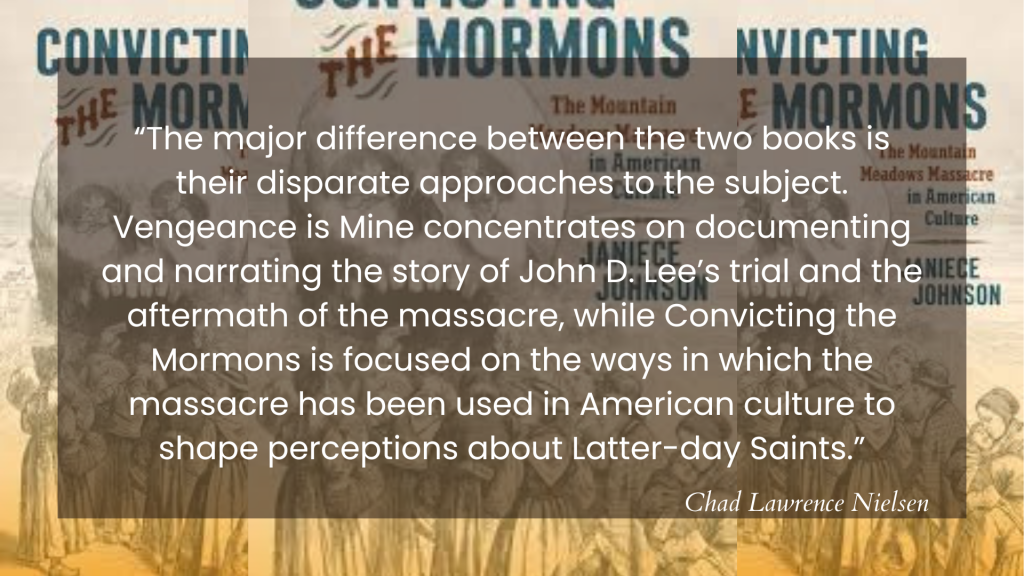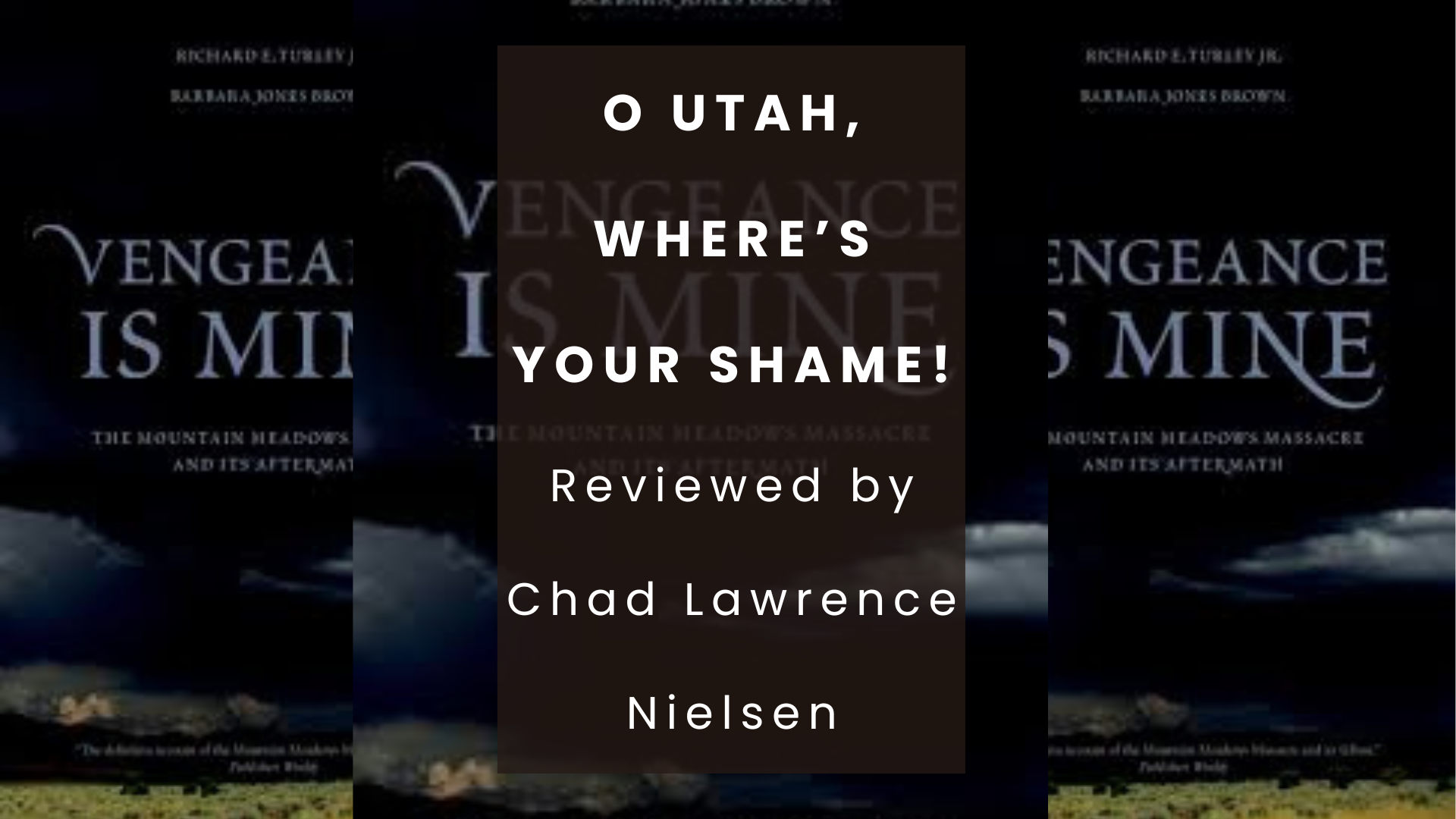Articles/Essays – Volume 58, No. 1
O Utah, Where’s Your Shame!: A Review ofTwo Mountain Meadows Massacre Books | Richard E. Turley, Jr., and Barbara Jones Brown, Vengeance Is Mine, and Janiece Johnson, Convicting the Mormons
The Mountain Meadows Massacre is a hugely important (and hugely tragic) topic in the history of both Utah and the Church of Jesus Christ of Latter-day Saints. That is why it is so notable that not one but two heavy-hitting books on the topic came out in 2023. In this review, I discuss both of these books—Vengeance Is Mine: The Mountain Meadows Massacre and Its Aftermath by Richard E. Turley Jr. and Barbara Jones Brown and Convicting the Mormons: The Mountain Meadows Massacre in American Culture by Janiece Johnson.
Turley and Brown’s Vengeance Is Mine is an exceptional book that delves deep into the outcomes and repercussions of the infamous Mountain Meadows Massacre. The authors have done a remarkable job of presenting a comprehensive and detailed account of the massacre and its cover-up.
The book is a sequel to the 2008 publication Massacre at Mountain Meadows and takes readers on a journey through the aftermath of the gruesome event. It quickly summarizes the history of the massacre before moving on to examine the attempts of the local southern Utah leaders to conceal their crime by suppressing witnesses and disseminating lies. Both government and Church investigations were hindered by stonewalling and political maneuvering, and the authors provide insight into these challenges. They also delve into the trial proceedings of John D. Lee, the only person executed for the massacre. Using resources previously unavailable (including new transcriptions of the shorthand notes of Lee’s trials), they analyze the complex relationship between Lee and Church president Brigham Young and question Young’s involvement in the cover-up. They find that the local leaders in southern Utah intentionally misled Brigham Young, blaming the massacre on Paiutes, which Young accepted until evidence to the contrary was shared with him in 1870 by Erastus Snow and Lorenzo Roundy, then confirmed by Nephi Johnson. For this and other reasons, the authors conclude that published memoirs of John D. Lee (Mormonism Unveiled) were “altered and expanded” from “Lee’s original and significantly shorter ‘confession’” by William W. Bishop. The book also details the fates of the other perpetrators and survivors, noting that “the pursuit of further convictions continued after Lee’s execution” (xv).
Turley and Brown’s writing is well researched and presents a balanced perspective. They successfully convey the gravity of the event while maintaining sensitivity to the victims and their families. Their willingness to confront the difficult aspects of this history is commendable and reflects a deeply held respect for the truth. While the book was not easy or light to read, I think it’s important to contend with this history.

The book provided new and interesting insight into the massacre. It made it very clear that even though John D. Lee was the only person ever successfully prosecuted and executed for carrying out the massacre, there were efforts to indict others. Those other efforts were thwarted by a variety of circumstances, including an inability to capture the suspects (like Isaac Haight), plea bargains for those testifying, and government agent refusals to accept assistance from the Church. The section of the book that was most new to me delved into the details of Lee’s trial. I learned, for instance, that the US attorneys in the first trial against Lee had a primary goal of putting pressure on Congress to pass legislation to disenfranchise Latter-day Saints and that a key struggle in the trial was establishing that Lee had killed people during the massacre (which proved more difficult that one might think).
Some aspects of the story still didn’t feel clear to me after finishing Vengeance Is Mine. In particular, the story of Isaac Haight’s membership being restored still felt hazy. The authors put his rebaptism in the context of Haight losing a daughter shortly before the rebaptism took place, but they did not connect the dots on how the two events were linked, if at all, or why Brigham Young made the sudden about-face and authorized rebaptism for Haight. Setting aside that minor criticism, the book is a historical tour de force in understanding the aftermath of the massacre.
Moving on, Johnson’s Convicting the Mormons combines an analysis of the records of Lee’s trials with a thorough understanding of American culture in order to illuminate the ways in which individuals and the media used (and continue to use) narratives of the Mountain Meadows Massacre as a weapon against the Church of Jesus Christ of Latter-day Saints in constructing Latter-day Saints as uncivilized and “other.”
In many ways, this book serves as an intersection of studies about the massacre (such as Vengeance Is Mine) with studies about anti-Mormon literature and what that literature says about the people who wrote it (following in the tradition of Viper on the Hearth by Terryl Givens, A Peculiar People: Anti-Mormonism and the Making of Religion in Nineteenth-Century America by J. Spencer Fluhman, or Sins of Christendom: Anti-Mormonism and the Making of Evangelicalism by Nathaniel Wiewora). Johnson also builds on the work of W. Paul Reeve (Religion of a Different Color) and others in discussing how Latter-day Saints were portrayed as no longer being white through anti-Mormon literature.
As an example of understanding the goals of the relevant anti-Mormon literature, Johnson demonstrates how Lee’s first trial was run with the newspaper more in mind than the jury. Throughout the trial, the US attorneys were crafting a narrative about the massacre that would be broadcast nationwide to stir up anger against the Church of Jesus Christ of Latter-day Saints rather than focusing on the jury in the courtroom, their goal being to “bring the savagery of the Mormon Church to ‘the eyes of the whole civilized world’” in order to pressure Congress to pass legislation that would punish the Church (49). Their narrative portrayed Latter-day Saints as violent, subservient to their leaders, and unmanly (both for their subservience and for failing to protect women and children during the massacre). This had the mixed effect of damaging the public perception of the Church but failing to lead the jury to convict John D. Lee for his crimes.
One of the enjoyable aspects of Convicting the Mormons is its incorporation of both media and prose text. Political cartoons litter the pages, and folk songs, Buffalo Bill Cody’s Wild West shows, modern TV series, and novels are all discussed to highlight the themes of anti-Mormon literature about the Mountain Meadows Massacre. (The Wild West shows also make for a nice link between this book and the more recently published Buffalo Bill and the Mormons by Brent M. Rogers.) The title of this review is, in fact, taken from a folk song discussed in Convicting the Mormons (35–36).
One notable aspect of Johnson’s writing is that she is able to dig beneath the surface and show how the story grew in the telling. For example, claims that Brigham Young was ultimately responsible for the massacre only really began to emerge during Lee’s first trial. Johnson notes that “in spite of the lack of evidence, the U.S. attorneys ensured that Young’s involvement became a central element of John D. Lee’s first trial and its enduring legacy” (111). The attorneys had already decided that President Young was guilty (regardless of what any evidence indicated) and refused to be convinced otherwise. This attitude resulted in the rejection of Lee’s confession during the first trial because it “shows, beyond the possibility of a doubt that Brigham Young is innocent and knew nothing of the transaction until many days after the massacre occurred” (97). Ultimately, when Lee’s attorney, William W. Bishop, published an edited version of a confession that implicated Young after Lee’s execution, Bishop “provided the narrative the public desired” by “inculpating Young in the massacre . . . and the public responded in kind buying the book in droves” (129).
Convicting the Mormons is a fascinating exploration of how the public image of Latter-day Saints has been deeply affected by the massacre (even while noting how similar massacres perpetrated by other American colonizers in the western United States tend to not receive similar treatments). Vengeance Is Mine is an exceptional book that serves as a valuable contribution to the history of Mormonism and Utah. The authors’ openness and depth of research is remarkable and presents a clear and thorough account of one of the most shameful events in Latter-day Saint history. The major difference between the two books is their disparate approaches to the subject. Vengeance is Mine concentrates on documenting and narrating the story of John D. Lee’s trial and the aftermath of the massacre, while Convicting the Mormons is focused on the ways in which the massacre has been used in American culture to shape perceptions about Latter-day Saints. Both are worthy additions to Latter-day Saint historical studies.
Richard E. Turley Jr. and Barbara Jones Brown. Vengeance Is Mine: The Mountain Meadows Massacre and Its
Aftermath. New York: Oxford University Press, 2023. 520 pp. Hardcover: $34.95. ISBN: 9780195397857.
Janiece Johnson. Convicting the Mormons: The Mountain Meadows Massacre in American Culture. Chapel Hill: University of North Carolina Press, 2023. 234 pp. Paperback: $29.95 ISBN: 9781469673530.


 Back to full Issue
Back to full Issue

